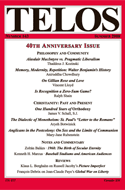On Tuesdays at the TELOSscope blog, we reach back into the archives and highlight an article whose critical insights continue to illuminate our thinking and challenge our assumptions. Today, Lev Marder looks at Aniruddha Chowdhury’s“Memory, Modernity, Repetition: Walter Benjamin’s History,” from Telos 143 (Summer 2008).
 Reaching into the Telos archive to retrieve Aniruddha Chowdhury’s essay “Memory, Modernity, Repetition: Walter Benjamin’s History” proves to be a troubling task. In the article, Chowdhury masterfully treats Benjamin’s concept of history, which I prefer to an extent to conflate with historiography. The more attentively one reads Chowdhury’s work, the more apparent it becomes that it resists being mundanely archived and treated just as another artifact. Sticking out of the archive, it also defies the reader who wonders where to start reading the text. Accustomed to starting from the beginning, the reader rarely questions the method of reading, the method of interpreting, and the mode of historiography. Without a doubt these questions relate to the (mis)understanding of temporality and its limits.
Reaching into the Telos archive to retrieve Aniruddha Chowdhury’s essay “Memory, Modernity, Repetition: Walter Benjamin’s History” proves to be a troubling task. In the article, Chowdhury masterfully treats Benjamin’s concept of history, which I prefer to an extent to conflate with historiography. The more attentively one reads Chowdhury’s work, the more apparent it becomes that it resists being mundanely archived and treated just as another artifact. Sticking out of the archive, it also defies the reader who wonders where to start reading the text. Accustomed to starting from the beginning, the reader rarely questions the method of reading, the method of interpreting, and the mode of historiography. Without a doubt these questions relate to the (mis)understanding of temporality and its limits.
Immediately an image of a straight line emerges, perhaps with an arrow in one direction. It is quite a benign image until one associates it with a spear: a destructive force. Chowdhury credits Benjamin’s attempt to reject history as a progressive movement, in favor of a more complex diachronic process of writing in allegories. Yet, this is not an attempt to avoid destruction and transcend limits. Piecing together and maintaining Benjamin’s conception of history, Chowdhury recognizes the destructive character invariably haunting history. Focusing on what seems to be a detail, such as that “decay is the origin. Original-history, in this sense, is originary historicity” (26), the perspective from which to judge or historicize life radically changes, placing the future and the after-death at the origin or even “dis-placing” the future in the past. As Chowdhury turns to questions of life and death, the complexity of Benjamin’s concept of history is further revealed, explicated, and clarified:
the historicity of art and language should be understood, Benjamin suggests, beyond the category of natural growth, ripening, and unfolding, and thus beyond the category of organic corporeality. Historicity signifies a movement of constant mortification and—this is Benjamin’s most crucial argument—”the course of its survival.” So, it is not so much life as after-life that determines the translatability and reproducibility of linguistic art work. The original itself attains its truth, its actuality, in its reproduction, which also means that the life of the original is already marked by death. The original lives on, as it were, after its death. The unforgettable is precisely that which lives on and makes its anachronic claim. It is the task of the translator (and analogously, of the historiographer) to respond to this claim. (28)
Where is the present? Complicate Benjamin’s historicity with just a present limit and already it becomes unthinkable how historians ignore the frontiers of historiography and how destructive a simplistic conception of history can be. Along with Chowdhury let us ask if allegory can fill the void. The answer cannot be a simple yes or no. However, it would certainly have to deal with the central themes of Chowdhury’s article: memory, modernity, and repetition in negotiating the dimensions and limits of historiography. Can historians learn from such writers as Benjamin, Proust, and Chowdhury not to dismiss destruction, not to be afraid of it, and consciously to acknowledge it in their writing?
Read the full version of Aniruddha Chowdhury’s“Memory, Modernity, Repetition: Walter Benjamin’s History” at the TELOS Online website. If you are affiliated with an institution that is an online subscriber to Telos, you have free access to our complete online archive. If not, you can purchase 24-hour access to this and other Telos articles at the low rate of $5/article.



